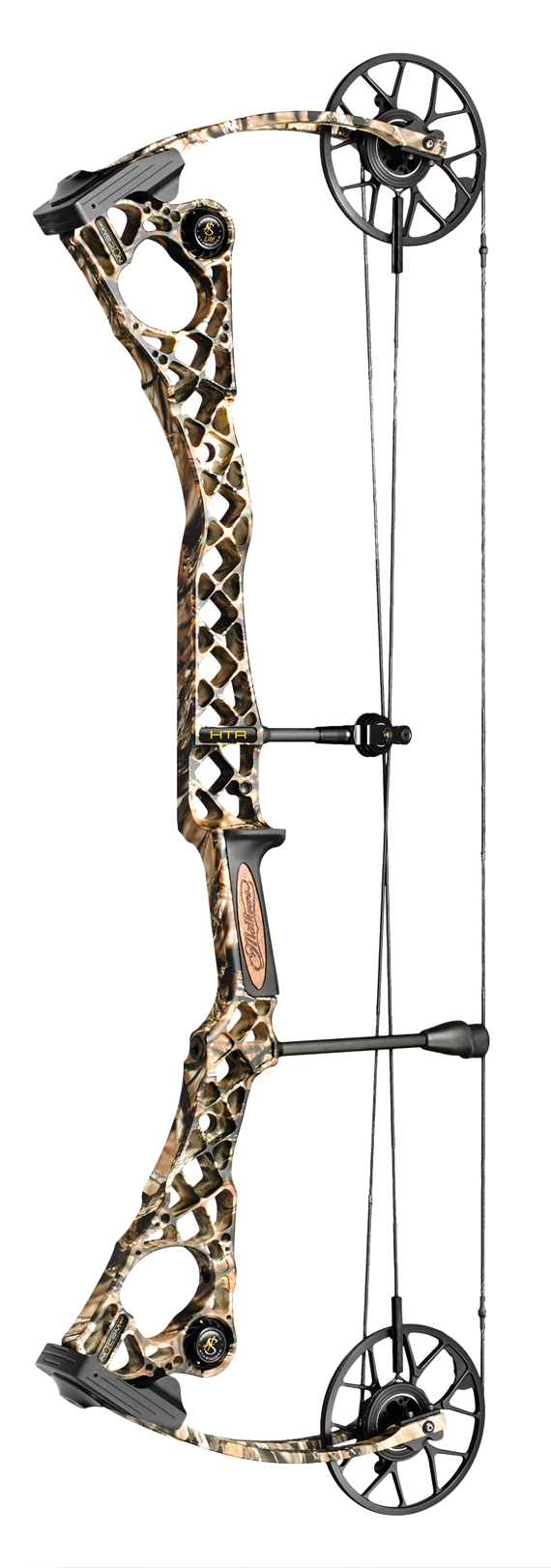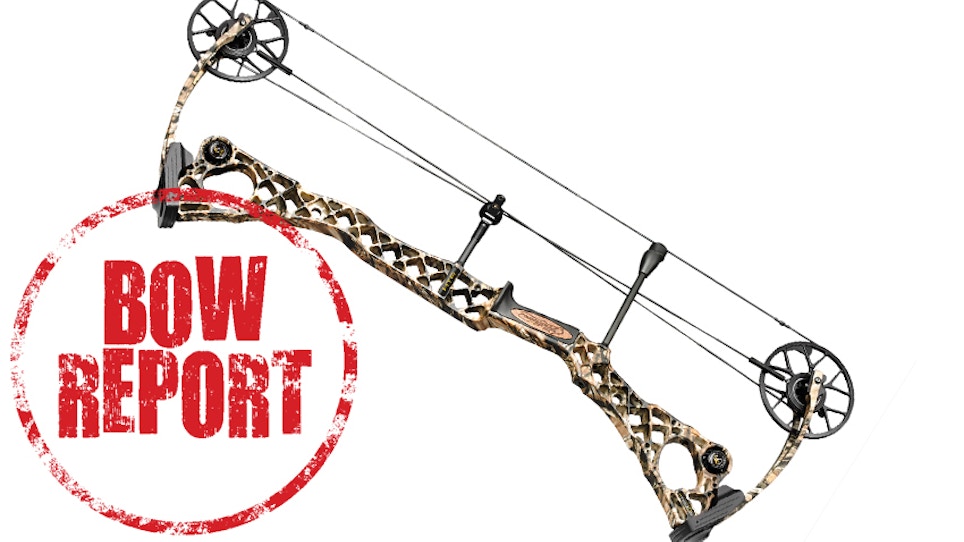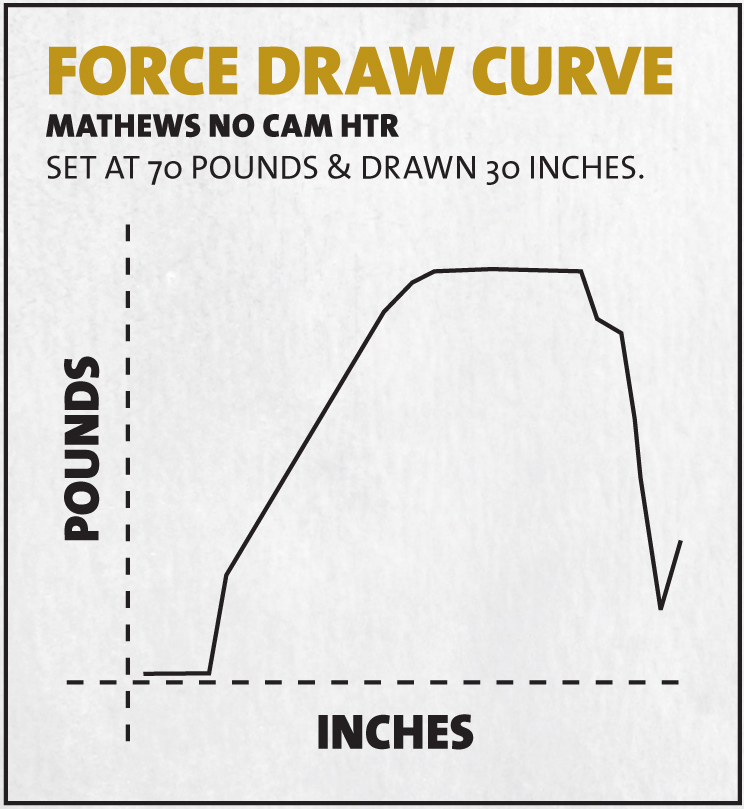Widely crediting Mathews with innovations ranging from single-cam systems to parallel limbs, harmonic dampers, reverse roller guards, perimeter-weighted cams and gridlock risers, observers of Mathews Inc. have been waiting for the next big innovation from Matt McPherson and his team. Time will tell if the No Cam system has the kind of influence on the industry the introduction of the single cam or the popularization of parallel limbs has had, but there is no denying the No Cam bows are radically different. (And, yes, I’ve been around long enough to remember the round-wheel bows. No comparison.)
Typically, modern compound bows make use of a camming action to build draw weight, which then drops quickly into a lower holding weight. Designers have done a remarkable job over the years of smoothing this cycle out while maintaining adequate and even very respectable speeds.
 The No Cam ST system employed on the HTR as well as on several target models is designed with what at a quick glance appears to be two idler wheels – it employs circular, concentric string tracks to ensure the string remains the same distance from the center of rotation throughout the draw cycle. Such a system offers some clear advantages, beginning with a very smooth feel when drawing and shooting the bow while promising totally level nock travel (certainly on the vertical plane, though this system should reduce cam lean and thus improve horizontal nock travel as well) and the negation of synchronization issues.
The No Cam ST system employed on the HTR as well as on several target models is designed with what at a quick glance appears to be two idler wheels – it employs circular, concentric string tracks to ensure the string remains the same distance from the center of rotation throughout the draw cycle. Such a system offers some clear advantages, beginning with a very smooth feel when drawing and shooting the bow while promising totally level nock travel (certainly on the vertical plane, though this system should reduce cam lean and thus improve horizontal nock travel as well) and the negation of synchronization issues.
One challenge of such a system is attaining good speed with a comfortable degree of letoff. Working around the No Cam system, Mathews designers developed a bow with an uncharacteristically long (for a Mathews bow) and barely reflexed riser and very short, skinny, past-parallel quad limbs. They also made use of Mathews’ recently introduced RockMods, offering the option of 65-, 75- and 85-percent letoff on the HTR. Other features found on the No Cam bows are the now-familiar Harmonic Stabilizers, Reverse Assist Roller Guard and the recently introduced Focus Grip.
The shortness of the limbs, together with the length and lack of reflex give the No Cam HTR a somewhat uncurvaceous appearance more common to a target bow than a hunting bow. Fit and finish on the bow tested was flawless, and I do like the Lost Camo. The wood inset on the grip with the carved logo adds a touch of Mathews class, as do the understated contrasting yellow and white logos on the limbs.
Shooting the Bow
It’s important to note that the No Cam HTR comes standard with the 85-percent letoff RockMod, so that is how I tested it. The published top IBO speed of 330 fps is based on the optional 65-percent RockMod.
Mathews bows are generally easy to set up and tune, and the HTR was, if anything, more so. The string stop was slightly recessed, and I backed it out so it was all but touching the string. I always notice any sticking or chatter in the limb bolts when adjusting draw weights; in this case the limb bolts turned smoothly with little effort. As with many bows, Mathews insists the limb bolts be backed down from the maximum draw weight before pressing the bow. Pressing required a little extra attention because of the very short limbs but did not present any difficulties. I’m a believer in paper tuning and was shooting bullet holes with my routine test setup in short order.
At a little over 4 pounds, the No Cam HTR is not inordinately heavy, but neither can it be called a lightweight bow. As I’ve observed in the past, long-riser bows tend to hold steady on target. At 32 inches axle to axle this is not a long bow overall, but the riser is proportionately long. Everything about the design of this bow, including the weight and the long riser as well as the No Cam system, seems intended to contribute to the stated goal of producing a super accurate bow, as well as a smooth-shooting one.
The smoothness is remarkable. There is a difference between effort and smoothness – even a smooth-drawing bow can seem to require extra effort to draw, and the fastest ones generally do. The No Cam HTR is both easy drawing and smooth. With the 85-percent module in place, it all but holds itself at full draw – a very nice feature when you’re holding on that big buck you’ve been watching on game cameras for months.
I always test bows with a stabilizer but usually remove the stabilizer for at least a few shots to note the difference. The difference in the case of this bow is a slight one. Even without a stabilizer it’s very quiet. It hops forward in the hand at the shot but with no discernible vibration.
I’m a fan of the Focus Grip. Custom options are available, but I find the grip comfortable while promoting a consistent non-torque-inducing hold.
Overall, though, the No Cam HTR is clearly a hunting bow and more than suitable for that task, it does have a feel similar to that of many target bows – not surprising in a bow designed with smooth shooting and tack-driving accuracy as its primary goals. It has the look of a target bow, too, but that is primarily because of the proportionately long riser. At 32 inches axle to axle, it will be ideal for treestands and ground blinds.
The more-than-adequate top speed approaching 330 fps might be a negative for shooters seeking the fastest, flattest-shooting bows on the market. Whether or not the No Cam design will influence the way bows are built in the future remains to be seen, but shooters who put a premium on forgiveness, accuracy and shootability – and who don’t judge a bow by the size of the gap between its sight pins – are going to like the No Cam HTR.
Mathews No Cam HTR Specs
Letoff:……………………… 65, 75, 85% optional
Brace Height:………………6 5/8 inches
Weight:…………………….. 4.14/4.3 pounds (approximate)
Axle-To-Axle Length:…….. 32 inches
Speed:……………………… 330 fps
Draw Lengths:…………….. 24 to 30 inches in half-inch increments
Draw Weights:…..………… 50, 60 and 70 pound peak, adjustable down 10 pounds from peak.
Options:…………………… Lost Camo, Stone Tactical, Tactical, Black Anthem, Lost OT Camo
Suggested Retail:………… $1,099
Objective Tests (30 Inches Draw)
Peak Hold*:…………………70 pounds
Weight, Full Draw*:………11.5 pounds
*Rounded to nearest half-pound
At 70-Pound Draw Weight
| Arrow Weight | Speed @ Launch | Speed @ 20 Yards | K.E. @ Launch | K.E. @ 20 Yards |
| 385 grains | 303 fps | 287 fps | 78.5 ft. lbs. |
70.5 ft. lbs. |
| 500 grains | 272 fps | 267 fps | 82 ft. lbs. | 79 ft. lbs. |
At 60-Pound Draw Weight
| Arrow Weight | Speed @ Launch | Speed @ 20 Yards | K.E. @ Launch | K.E. @ 20 Yards | Sound Level |
| 385 grains | 291 fps | 277 fps | 69.5 ft. lbs. | 65.5 ft. lbs. | 56.7 dBA |
| 500 grains | 258 fps | 245 fps | 71 ft. lbs. | 66.5 ft. lbs. | 52.9 dBA |







